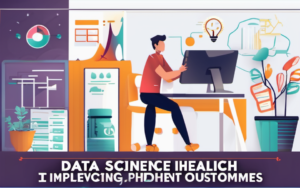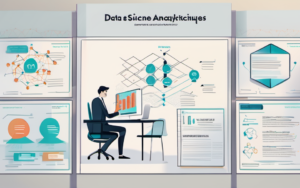In today’s data-driven world, organizations are increasingly relying on data to make informed decisions. This shift towards data-driven decisions has transformed the way businesses operate, enabling them to gain a competitive edge and achieve better outcomes. This post will delve into the key principles, benefits, challenges, and best practices of data-driven decision-making, using real-world case studies to illustrate its power.
The Rise of Data-Driven Decision-Making
The surge in data availability, coupled with advancements in data analytics technologies, has paved the way for data-driven decision-making. Organizations are now able to collect, analyze, and interpret vast amounts of data, extracting valuable insights that inform their strategic choices. This paradigm shift has led to a data-driven culture in various industries, from e-commerce to healthcare.
Benefits of Data-Driven Decision-Making
Data-driven decisions offer numerous advantages over traditional decision-making methods based on intuition or experience. These benefits include:
- Improved Accuracy and Precision: Data analysis allows for a more objective and accurate assessment of situations, leading to better-informed decisions.
- Enhanced Efficiency and Productivity: By identifying patterns and trends in data, organizations can streamline processes, optimize resource allocation, and improve overall efficiency.
- Increased Revenue and Profitability: Data-driven insights can help identify growth opportunities, optimize pricing strategies, and improve marketing campaigns, ultimately boosting revenue and profitability.
- Reduced Risk and Uncertainty: Data analysis can help mitigate risk by identifying potential problems and opportunities, enabling organizations to make proactive decisions and avoid costly mistakes.
Challenges of Data-Driven Decision-Making
While data-driven decision-making offers significant benefits, it also presents several challenges:
- Data Quality and Integrity: Ensuring data accuracy and completeness is crucial for meaningful insights. Poor data quality can lead to flawed decisions and wasted resources.
- Data Security and Privacy: Handling sensitive data requires robust security measures to protect customer privacy and comply with regulations.
- Data Analysis Skills and Expertise: Effective data analysis requires specialized skills and expertise, which may be scarce or expensive.
- Data Overload and Complexity: The sheer volume and complexity of data can make it challenging to extract meaningful insights and make sense of it all.
Key Principles of Data-Driven Decision-Making
Data-driven decision-making is not just about collecting and analyzing data; it’s a structured process that involves several key principles:
Data Collection and Integration
The first step in data-driven decision-making is to collect relevant data from various sources, including internal systems, customer interactions, market research, and external databases. This data needs to be integrated into a unified system for analysis and interpretation.
Data Analysis and Interpretation
Once the data is collected and integrated, it needs to be analyzed using appropriate statistical and analytical techniques. This involves identifying patterns, trends, and relationships in the data to extract meaningful insights.
Decision-Making and Implementation
The insights gained from data analysis should be used to inform decision-making. This involves translating data insights into actionable strategies and implementing them to achieve desired outcomes.
Monitoring and Evaluation
After implementing data-driven decisions, it’s essential to monitor their impact and evaluate their effectiveness. This feedback loop allows for continuous improvement and refinement of the decision-making process.
Case Studies of Data-Driven Decision-Making
Here are three real-world case studies that illustrate the power of data-driven decision-making:
Case Study 1: Marketing Optimization
A leading e-commerce company used data analysis to optimize its marketing campaigns. By analyzing customer data, including browsing history, purchase history, and demographics, they identified key customer segments and tailored marketing messages accordingly. This data-driven approach resulted in a significant increase in conversion rates and customer engagement.
Case Study 2: Supply Chain Management
A global manufacturing company implemented a data-driven approach to manage its supply chain. By analyzing historical sales data, market trends, and supplier performance, they were able to optimize inventory levels, reduce lead times, and minimize disruptions. This resulted in significant cost savings and improved customer satisfaction.
Case Study 3: Healthcare Analytics
A healthcare provider used data analysis to improve patient outcomes. By analyzing patient data, including medical records, lab results, and treatment history, they identified patients at risk of developing certain conditions. This enabled them to provide targeted interventions and improve overall patient care.
Best Practices for Data-Driven Decision-Making
To effectively leverage data-driven decision-making, organizations should adopt the following best practices:
Establish Clear Goals and Objectives
Before embarking on any data-driven initiative, it’s essential to define clear goals and objectives. This will ensure that the data collected and analyzed is relevant to the desired outcomes.
Ensure Data Quality and Integrity
Data quality is paramount for accurate insights. Organizations should implement data governance policies and procedures to ensure data accuracy, completeness, and consistency.
Utilize Appropriate Data Analysis Techniques
Choosing the right data analysis techniques is crucial for extracting meaningful insights. Organizations should leverage statistical methods, machine learning algorithms, and other tools to analyze data effectively.
Communicate Insights Effectively
Data insights are only valuable if they are communicated effectively to decision-makers. This requires clear and concise presentations, visualizations, and storytelling to convey complex data in an understandable way.
Foster a Data-Driven Culture
To fully embrace data-driven decision-making, organizations need to foster a culture that values data, encourages experimentation, and rewards data-informed decisions. This involves providing training, promoting data literacy, and creating a collaborative environment.
The Future of Data-Driven Decision-Making
The future of data-driven decision-making is bright, with advancements in artificial intelligence, machine learning, and big data analytics continuing to shape the landscape. Organizations will increasingly rely on advanced analytics techniques to extract deeper insights from data, enabling them to make even more informed and impactful decisions.
The key takeaway is that data-driven decision-making is no longer a trend; it’s a necessity for organizations looking to thrive in a data-driven world. By following best practices and embracing a data-driven culture, businesses can unlock the full potential of data and gain a competitive edge in their respective markets.




